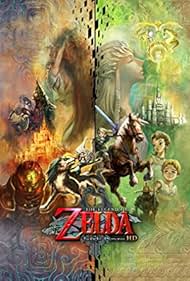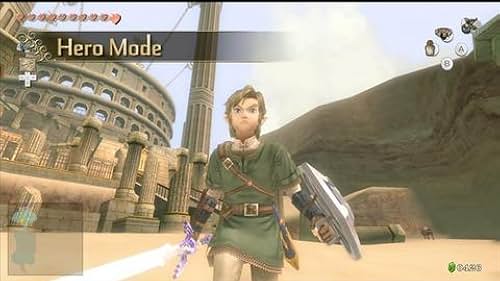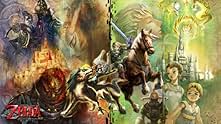When an otherworldly darkness covers the land, a young knight teams up with an imp on a quest to defeat the King of Shadows.When an otherworldly darkness covers the land, a young knight teams up with an imp on a quest to defeat the King of Shadows.When an otherworldly darkness covers the land, a young knight teams up with an imp on a quest to defeat the King of Shadows.
- Awards
- 1 win
Photos
Junji Kitajima
- Zant
- (archive sound)
- (voice)
Akiko Kômoto
- Midna
- (archive sound)
- (voice)
- (as Akiko Koumoto)
Hironori Miyata
- Ganndorf
- (archive sound)
- (voice)
Jun Mizusawa
- Princess Zelda
- (archive sound)
- (voice)
Akira Sasanuma
- Link
- (archive sound)
- (voice)
Juri Takita
- Ilia
- (archive sound)
- (voice)
Yuiko Tatsumi
- Agitha
- (archive sound)
- (voice)
Storyline
Did you know
- TriviaLike the previous high-definition port in the Zelda series (The Legend of Zelda: The Wind Waker HD (2013)), this HD remake was released during the 10-year anniversary of its original, The Legend of Zelda: Twilight Princess (2006).
- GoofsIlia remembers that she was being held captive in the Hidden Village, before escaping to Hyrule Castle Town. The Gorons, however, remark that the village has been inaccessible for a long time due to a rockslide. It is never explained how Ilia was able to get in and out of the village, if it is supposed to be completely sealed off.
- ConnectionsFeatured in Outside Xtra: 7 Times You Got Sassed for Never Talking (2017)
Featured review
I have been a big fan of The Legend of Zelda since its humble beginnings on the NES, and those who know me well have frequently heared my praise for the original GameCube/Wii version of Twilight Princess. Not only is it one of the best Zelda games in my opinion, but also one of the best video games ever made. So seeing this masterpiece rendered in full HD feels like justice has been served: a game finally presented in its intended form.
Like Wind Waker HD which also got the remastering treatment, Twilight Princess looks better than ever. With its widely varying array of vistas, mountains, cities, ruins and fields, you might say that TP benefits even more from this higher resolution. The first time you enter Hyrule Field or Lake Hylia is almost an assault on the senses, with so many beautiful details demanding attention. There is nothing quite as magic as standing in the Gerudo Desert at dawn, watching the sun slowly illuminating the vast area, and the splendor of a majestous and bustling city like Castle Town is especially rewarding with HD quality image and surround sound.
Spectacular video quality aside, the sturdy foundation of this game lies not in its graphics, but in its solid storytelling. I will maintain that this is still one of the most interactive games ever, where gameplay and story are in delicate balance. Most games simply start with a prologue and a tutorial, and then linger off into a series of interconnected fetch quests that lead to the ending. However, the screenwriters of TP have done a tremendous job trying to hide the obvious game sequence by cleverly interweaving it with the plot.
The story kicks off with a search for a couple of missing children, which serves to familiarize the player with the controls, the important areas in the game and its dual worlds system: as there is a Light World, there appears to be a world of Twilight as well, and its evil denizens have launched an attack on Hyrule. The dark creatures attack you at times, but after their defeat, they leave behind a portal that Link can use for warping, a nice example of how story and gameplay go hand in hand.
There are scripted events that take us to unexpected places or situations, and many of them have some kind of challenge to overcome, which makes such discoveries much more fun and engaging, instead of just roaming around. What is unique is that the narrative not only connects the dungeons in a logic way; it often continues inside the dungeons as well. Technically, your main objective there is to get inside and obtain Fused Shadows or Mirror Fragments, but the game makes us believe that we are really looking for children, helping out Gorons and Zoras, searching for a giant snow monster or soup ingredients, or discovering an ancient civilization.
In the meanwhile, the journey also introduces the player to important NPCs such as Midna, a sassy, imp-like character who finally breaks with the stereotype of the annoying sidekick who is only there to constantly tell us what to do. Granted, she DOES tell us what to do, but she also has a backstory and agenda of her own. Throughout the game, she bonds with Link in ways that thicken the plot considerably, especially when she introduces Link to the series' namesake Zelda. Over the course of an epic adventure, Link builds a whole network of allies who aid him in his quest, like animals, bar ladies, scholars and fellow warriors, so for once it doesn't feel like the entire fate of the world rests on the shoulders of one humbe stableboy while the rest of Hyrule takes a backseat.
The developers seem to have been inspired by the Lord of the Rings movies, with armies of Boboklins that look suspiciously like Orcs, a main focus on sword fighting and archery, sweeping shots of lush landscapes with ancient ruins, and a couple of horseback chases that definitely sell the epic factor. But the game always retains its own unique feeling, with familiar elements from the series like Gorons, Zoras and the Temple of Time. What also helps is that Hyrule looks a lot like the Hyrule we have come to know from Ocarina of Time, with its majestic Hyrule Field and the castle in the middle, surrounded by familiar mountains, lakes, waterfalls and deserts (and some new ones). But most of these are spectacularly bigger now, so having your trusted horse Epona from the beginning is quite an asset.
As for the switch from the Wii to the Wii U, we unfortunately lost the cool feature to aim with the Wiimote, but the Wii U gamepad largely compensates for this with its gyroscopic function. It is also much easier to check a map, assign items to buttons or change into a wolf and back by using the gamepad, instead of having to go to pause screens all the time. And this version reintroduces the ability to move the camera, which was impossible on the Wii due to lack of remaining joysticks.
Like Ocarina of Time and its 3DS remake, IMDb voters seem to appreciate this HD version somewhat less than its original version, which may have to do with the relative lack of new additions. There is a new cave that can be unlocked with an Amiibo which is quite a challenge, but it is still more of a minigame than a true expansion. Maybe the old game was already near-perfect to begin with, and this new version doesn't really improve on it as the Wind Waker HD did on its forebearer. But it shouldn't matter to the biggest fans. If you loved the old version and think it is worth a HD replay, this is the game to buy.
Like Wind Waker HD which also got the remastering treatment, Twilight Princess looks better than ever. With its widely varying array of vistas, mountains, cities, ruins and fields, you might say that TP benefits even more from this higher resolution. The first time you enter Hyrule Field or Lake Hylia is almost an assault on the senses, with so many beautiful details demanding attention. There is nothing quite as magic as standing in the Gerudo Desert at dawn, watching the sun slowly illuminating the vast area, and the splendor of a majestous and bustling city like Castle Town is especially rewarding with HD quality image and surround sound.
Spectacular video quality aside, the sturdy foundation of this game lies not in its graphics, but in its solid storytelling. I will maintain that this is still one of the most interactive games ever, where gameplay and story are in delicate balance. Most games simply start with a prologue and a tutorial, and then linger off into a series of interconnected fetch quests that lead to the ending. However, the screenwriters of TP have done a tremendous job trying to hide the obvious game sequence by cleverly interweaving it with the plot.
The story kicks off with a search for a couple of missing children, which serves to familiarize the player with the controls, the important areas in the game and its dual worlds system: as there is a Light World, there appears to be a world of Twilight as well, and its evil denizens have launched an attack on Hyrule. The dark creatures attack you at times, but after their defeat, they leave behind a portal that Link can use for warping, a nice example of how story and gameplay go hand in hand.
There are scripted events that take us to unexpected places or situations, and many of them have some kind of challenge to overcome, which makes such discoveries much more fun and engaging, instead of just roaming around. What is unique is that the narrative not only connects the dungeons in a logic way; it often continues inside the dungeons as well. Technically, your main objective there is to get inside and obtain Fused Shadows or Mirror Fragments, but the game makes us believe that we are really looking for children, helping out Gorons and Zoras, searching for a giant snow monster or soup ingredients, or discovering an ancient civilization.
In the meanwhile, the journey also introduces the player to important NPCs such as Midna, a sassy, imp-like character who finally breaks with the stereotype of the annoying sidekick who is only there to constantly tell us what to do. Granted, she DOES tell us what to do, but she also has a backstory and agenda of her own. Throughout the game, she bonds with Link in ways that thicken the plot considerably, especially when she introduces Link to the series' namesake Zelda. Over the course of an epic adventure, Link builds a whole network of allies who aid him in his quest, like animals, bar ladies, scholars and fellow warriors, so for once it doesn't feel like the entire fate of the world rests on the shoulders of one humbe stableboy while the rest of Hyrule takes a backseat.
The developers seem to have been inspired by the Lord of the Rings movies, with armies of Boboklins that look suspiciously like Orcs, a main focus on sword fighting and archery, sweeping shots of lush landscapes with ancient ruins, and a couple of horseback chases that definitely sell the epic factor. But the game always retains its own unique feeling, with familiar elements from the series like Gorons, Zoras and the Temple of Time. What also helps is that Hyrule looks a lot like the Hyrule we have come to know from Ocarina of Time, with its majestic Hyrule Field and the castle in the middle, surrounded by familiar mountains, lakes, waterfalls and deserts (and some new ones). But most of these are spectacularly bigger now, so having your trusted horse Epona from the beginning is quite an asset.
As for the switch from the Wii to the Wii U, we unfortunately lost the cool feature to aim with the Wiimote, but the Wii U gamepad largely compensates for this with its gyroscopic function. It is also much easier to check a map, assign items to buttons or change into a wolf and back by using the gamepad, instead of having to go to pause screens all the time. And this version reintroduces the ability to move the camera, which was impossible on the Wii due to lack of remaining joysticks.
Like Ocarina of Time and its 3DS remake, IMDb voters seem to appreciate this HD version somewhat less than its original version, which may have to do with the relative lack of new additions. There is a new cave that can be unlocked with an Amiibo which is quite a challenge, but it is still more of a minigame than a true expansion. Maybe the old game was already near-perfect to begin with, and this new version doesn't really improve on it as the Wind Waker HD did on its forebearer. But it shouldn't matter to the biggest fans. If you loved the old version and think it is worth a HD replay, this is the game to buy.
Details
Contribute to this page
Suggest an edit or add missing content



